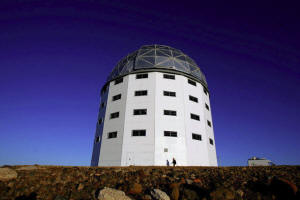|
 Africa's
giant eye in the sky proving worth its SALT Africa's
giant eye in the sky proving worth its SALT
 Send a link to a friend
Send a link to a friend
[April 30, 2016]
By Wendell Roelf
SUTHERLAND, South Africa (Reuters) - South
Africa’s SALT telescope has helped detect the first white dwarf pulsar,
the latest co-discovery that has astronomers eager to use the largest
optical telescope in the southern hemisphere to unlock the galaxy's
secrets.
|
|
 Quick reaction times, as well as being significantly cheaper than
similar European or American facilities in producing the science are
key competitive advantages, said a senior astronomer at the SALT
consortium during a media visit. Quick reaction times, as well as being significantly cheaper than
similar European or American facilities in producing the science are
key competitive advantages, said a senior astronomer at the SALT
consortium during a media visit.
“SALT is now living up to expectations, producing high-quality
science data that probe the far reaches of the universe,” said Ted
Williams, a director at the South African Astronomical Observatory
managing the site.
Scientists know of neutron stars, large objects about the size of
the Sun that have compacted down at the end of their lives to
something about 10 km (six miles) across, the last stop before a
black hole.
Williams said these incredibly dense objects have been known for
decades to produce pulsars, which emit regular pulses of radio waves
and other electromagnetic radiation at rates of up to one thousand
pulses per second.
 “But there is another class of compact objects called white dwarfs,
bigger, the size of the earth. So rather than 10 kilometers in size
we are looking at 6,000 kilometers and we’ve just discovered the
very first white dwarf pulsar,” he said of the previously unknown
celestial phenomena.
Situated atop a hill in the desolate Northern Cape around 350 km
north of Cape Town, the $43 million SALT telescope used its powerful
spectroscopy light measurement tool to prove the existence of the
white dwarf pulsar.
Shared by a consortium of partners from South Africa, India, America
and Europe, SALT’s queuing system allows it to interrupt routine
observations and within minutes focus its 10-metre optical telescope
on new discoveries, said Williams.
[to top of second column] |

In February, SALT was the first major telescope to take a spectrum
of a supernova in the nearby Centaurus A galaxy hours after its
discovery.
It also helped reveal one of the biggest explosions ever recorded in
the universe, 200 times more powerful than a typical supernova and
believed to have shone at 570 billion times the brightness of the
Sun.
“It is what we wanted for South Africa and for Africa, not to stay
at the margins but actually at the center and beginning to do
world-class quality work,” said Naledi Pandor, South Africa’s
science minister who visited the telescope on Friday.
Together with Australia, South Africa is also co-hosting the world's
biggest and most advanced radio telescope, the $2 billion "Square
Kilometre Array" which will study the origins of the universe and
help probe for extraterrestrial life.
(Reporting by Wendell Roelf; Editing by Kim Coghill)
[© 2016 Thomson Reuters. All rights
reserved.]
Copyright 2016 Reuters. All rights reserved. This material may not be published,
broadcast, rewritten or redistributed.
 |